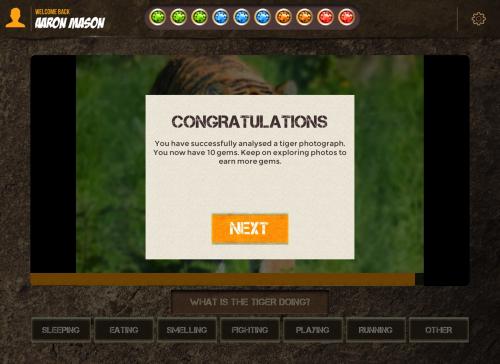As regular readers of this blog will know, I’m a big fan of the new wave of citizen science projects that take a gamified approach to getting people involved in science.
Most of these projects have been around furthering our knowledge of biological issues, whether that’s neuroscience or RNA.
A recent project from researchers at my alma mater, the University of Surrey, is applying the approach to allow players to help the conservation of rare and endangered species.
The project, known as Wildsense, was formed out of the Digital Ecosystem research group. The game asks players to analyze photos that have been loaded into the game from the web. Successful analysis is rewarded with points, with the overall game data then collated and analyzed to better understand animal movement and behavior.
For instance, the game might pull in photos of tigers from the various Indian tiger reserves that tourists have uploaded to Facebook or Instagram. The researchers believe that such photos are under-used at the moment and could provide some valuable information, for instance in the fight against poaching.
“People love to share photos online and the information about wildlife through these channels is vast and potentially very useful. We decided to turn this social data into a game that consolidates information on endangered animals and lets wildlife enthusiasts have a direct impact on welfare in an interactive way,” the researchers say.
“Our initial focus is wild tigers, which is a challenge as it is difficult to distinguish between photos of actual tigers from the vast number of images online. If you type the word ‘tiger’ in a search engine you get inundated with everything from famous golf players to baseball teams and cuddly toys. Our algorithms sort images by relevance using image metadata, which includes location, usernames and tags, successfully separating images of real tigers in the wild from other images online.”
 The developers believe that by monitoring particular species, they can gain a great understanding of things such as their habitat, and also insight into the behavior of the animals themselves.
The developers believe that by monitoring particular species, they can gain a great understanding of things such as their habitat, and also insight into the behavior of the animals themselves.
“The Wildsense app is an important step forward in our programme of developing methods to track wild animals without resorting to intrusive physical tags or collars“, they say.
It’s hoped that the app will provide an innovative way of making knowledge sharing both practical and accessible. It should allow the latest generation of citizen scientists with the opportunity to have an active role into wildlife observation and conseration.
As such it’s a very welcome addition to the burgeoning citizen science landscape, and well worth checking out if you’re interested in wildlife or conservation in any way.
It's fantastic that people can get involved in projects that interest them like this. It's a superb time to be alive (and inquisitive)